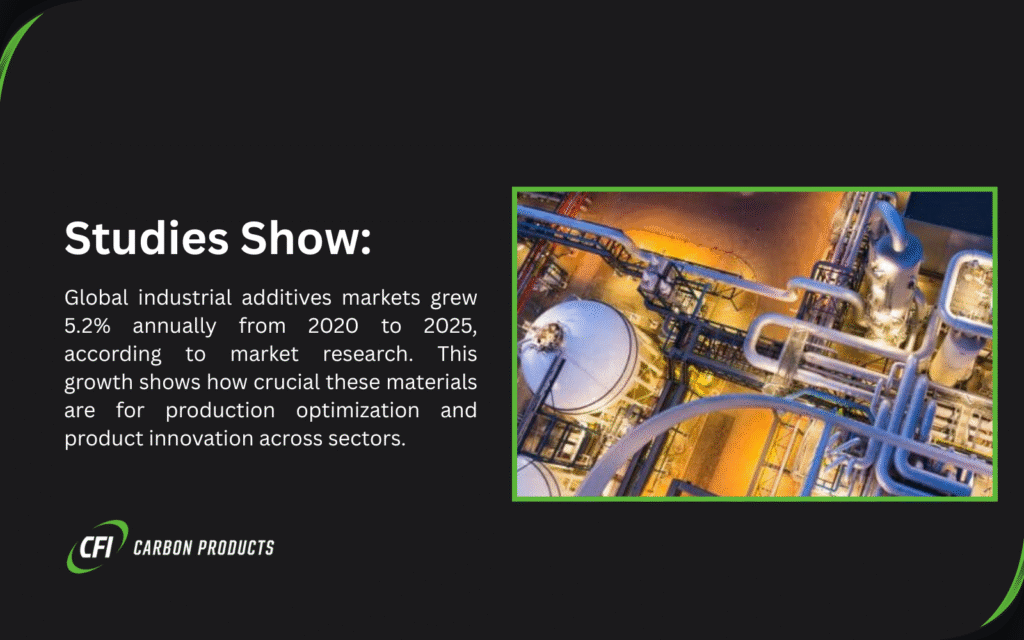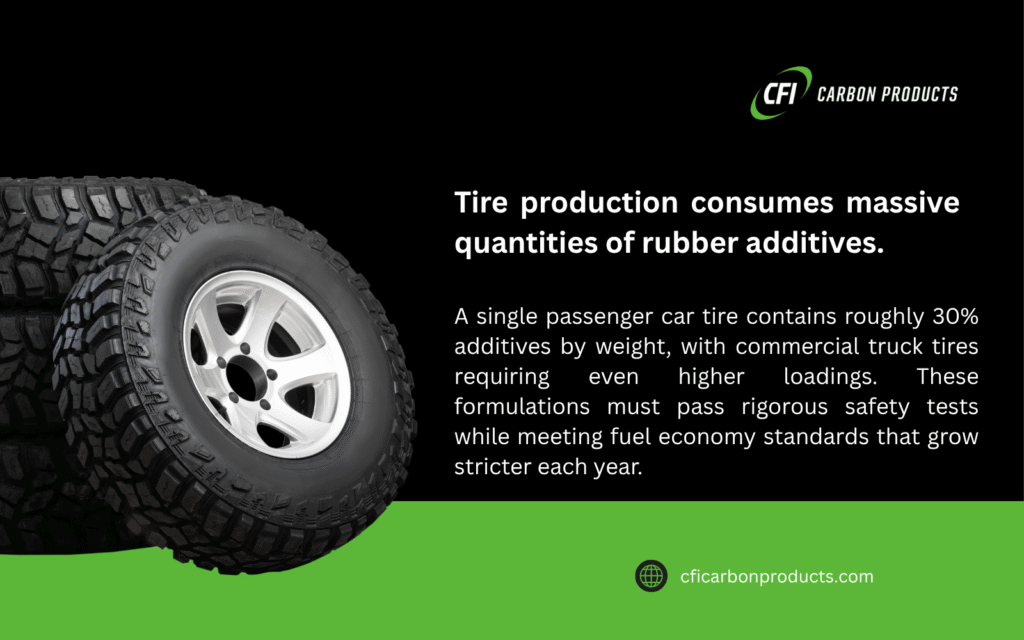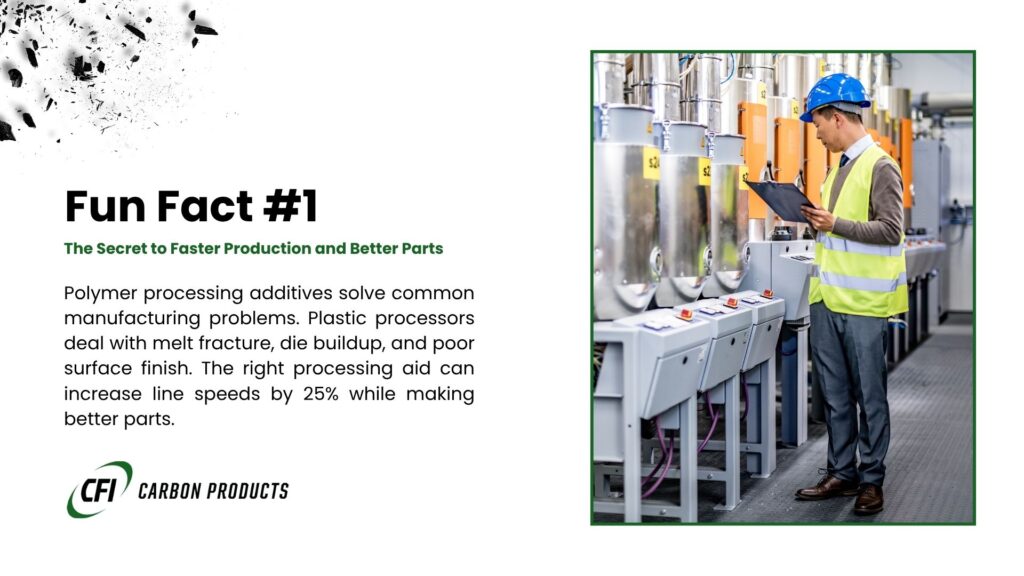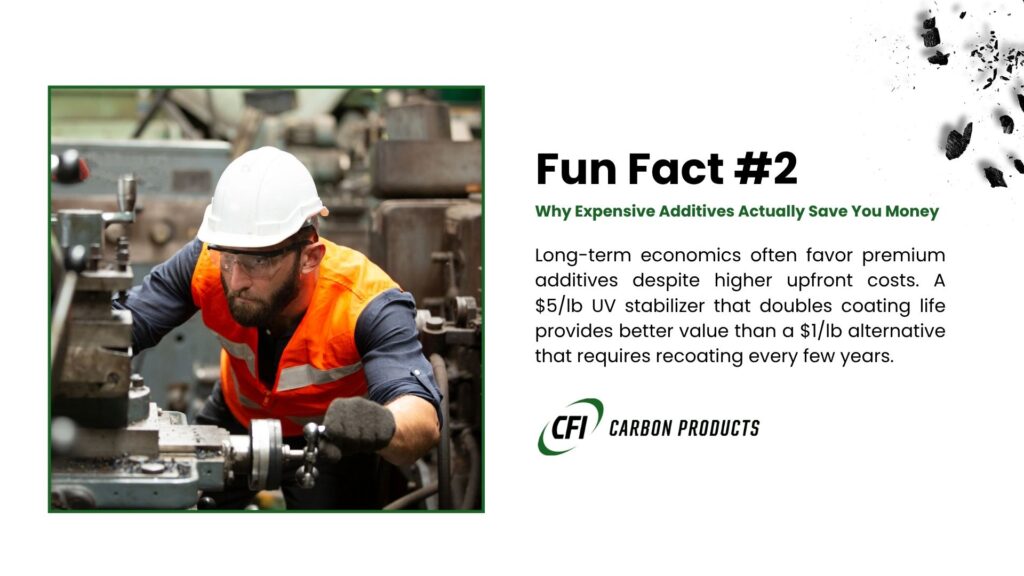The industry today uses industrial additives to better product performance, reduce costs, and meet environmental standards.
In this guide, we will analyze these special compounds and how they alter base materials in the production of rubber, plastics, coatings, and silicones.
We will talk about the science of additives, industrial applications, and how they increase performance, and teach methods for selecting them in industrial applications.
Manufacturers learn about minimizing production costs, improving quality, and meeting environmental regulations using industrial additives.
What Are Industrial Additives?
Industrial additives are specialized compounds that change and improve base material properties during production. These substances form the foundation of modern manufacturing, turning basic materials into high-performance products that meet strict industry standards.
Industrial additives work through chemical bonding, physical reinforcement, and molecular changes. The right selection and application can drastically change material traits like strength, flexibility, color, conductivity, and heat resistance. Selection needs a careful review of end-use needs, processing conditions, and regulatory standards.

Core Functions of Industrial Additives in Manufacturing
Performance Enhancement
Industrial additives serve multiple roles that directly affect product quality and manufacturing efficiency. Main performance improvements include better mechanical properties, smoother processing, and longer product life. These changes often create materials that beat baseline specs while staying cost-effective.
Filler additives like Austin Black 325 offer specific benefits: lighter material weight, better dimensional stability, and improved surface traits. These properties create measurable cost savings through less raw material use and better manufacturing speed.
Processing Optimization
Manufacturing efficiency gets major advantages from well-chosen industrial additives. These compounds can lower processing temperatures, cut cycle times, and reduce equipment wear. Combined, these improvements often mean big cost cuts and higher production capacity.
Temperature control matters critically for additive performance. Many industrial additives work best within specific temperature ranges, requiring careful process design to maximize benefits. Good temperature management improves additive spread, cuts processing time, and boosts final product quality.
Industrial Additives Performance Metrics
Before examining sector applications, manufacturers need to understand how different additive categories perform across key metrics.
| Performance Metric | Reinforcing Fillers | Processing Aids | Stabilizers | Colorants |
| Mechanical Strength | +40-60% | +5-15% | No Change | No Change |
| Processing Speed | -10-20% | +25-45% | +5-10% | +10-20% |
| Cost Impact | +15-25% | +8-15% | +12-20% | +20-35% |
| Temperature Stability | +30-50°C | +10-20°C | +80-120°C | +20-40°C |
| Environmental Impact | Moderate | Low | Low | Variable |
Industrial Additives Across Manufacturing Sectors
Rubber Industry Applications
Rubber production heavily uses industrial additives to reach desired performance levels. Carbon-based fillers and reinforcing agents change rubber compounds to meet specific needs for automotive, industrial, and consumer uses.
Rubber compounds face unique challenges that additives must address. High-stress applications like tires need compounds that balance multiple properties simultaneously.
The automotive sector alone consumes over 60% of synthetic rubber production, with each application demanding specific additive combinations.
| Additive Category | Function | Typical Loading % | Cost per Pound | Performance Gain |
| Carbon Black N330 | Reinforcement | 30-50% | $0.65-0.85 | +200% tensile |
| Silica Fillers | Low Rolling Resistance | 15-25% | $0.90-1.20 | +15% fuel efficiency |
| Processing Oils | Workability | 5-15% | $0.45-0.65 | +30% processing speed |
| Antioxidants | Aging Resistance | 1-3% | $2.50-4.00 | +300% service life |
| Accelerators | Cure Control | 0.5-2% | $3.00-5.50 | +50% cure rate |
Carbon black for rubber serves as the backbone of tire manufacturing. Major tire companies spend millions annually on additive research, with some compounds costing over $6 per pound yet providing performance gains that justify the expense.

Plastics Industry Integration
Plastic production uses dozens of additive types to solve processing problems and meet performance targets. Each plastic family – polyethylene, polystyrene, PVC, polyurethane – needs different additive approaches.
The plastics industry processes over 400 million tons annually worldwide, with additives representing 15-20% of total material costs. Additive selection can make or break product economics, especially in high-volume consumer goods where penny-per-pound differences matter significantly.
| Plastic Type | Primary Additives | Loading Range | Processing Temp °C | Key Challenge |
| Polyethylene | Antioxidants, UV stabilizers | 0.5-2% | 180-220 | Thermal degradation |
| PVC | Heat stabilizers, plasticizers | 3-15% | 160-200 | HCl evolution |
| Polystyrene | Flame retardants, colorants | 2-8% | 200-250 | Brittleness |
| Polyurethane | Catalysts, surfactants | 1-5% | 50-80 | Foam control |
| Polypropylene | Nucleating agents, clarifiers | 0.1-1% | 220-260 | Crystallization |
Plastic additives span from simple colorants to complex stabilizer systems. High-end automotive plastics might contain 20+ different additives, each serving a specific function. Part failure analysis often traces back to inadequate additive selection rather than base polymer issues.
PVC additives face the toughest challenges in plastics. PVC releases hydrogen chloride during processing, which attacks equipment and degrades properties.
Lead-based stabilizers once dominated but environmental concerns pushed the development of calcium-zinc and organotin alternatives. These newer systems cost more but offer better long-term performance.

Automotive Coating Additives Performance
Automotive coatings face extreme conditions that demand specialized additive systems. Each coating layer – primer, basecoat, clearcoat – uses different additives to meet specific performance requirements.
| Coating Layer | Key Additives | Loading % | Function | Performance Target |
| E-coat Primer | Corrosion inhibitors | 2-5% | Metal protection | 1000+ hrs salt spray |
| Primer Surfacer | Rheology modifiers | 1-3% | Flow control | <2 micron roughness |
| Basecoat | Effect pigments | 5-25% | Color/appearance | Color match ΔE <0.5 |
| Clearcoat | UV absorbers | 2-4% | Durability | 10+ years Florida exposure |
Paint formulations for automotive use contain 15-30% additives by weight. A typical metallic basecoat might include aluminum flakes, mica platelets, rheology modifiers, wetting agents, and defoamers. Each additive must work with others without causing compatibility problems.
UV additives for paint face a constant battle against photodegradation. Florida exposure testing subjects coatings to intense UV radiation, high temperatures, and humidity cycles. Coatings that survive 5+ years in Florida typically last 15+ years in moderate climates. The best UV packages cost $8-12 per gallon but prevent total coating failure.
Additives for wood coating deal with substrate movement, moisture absorption, and tannin bleeding. Wood expands and contracts with humidity changes, creating stress that can crack rigid coatings.
Flexible additives allow coatings to move with the substrate while maintaining adhesion.
Silicone and Polyurethane Additive Systems
Silicone applications need specialized additives for cure control, adhesion, and thermal stability. These systems often cure at room temperature, making additive compatibility critical for success.
| Silicone Type | Catalyst System | Cure Time | Service Temp °C | Primary Applications |
| RTV-1 Acetoxy | Tin catalysts | 24-48 hrs | -40 to +150 | General purpose sealants |
| RTV-1 Neutral | Titanium catalysts | 12-24 hrs | -50 to +200 | Electronic potting |
| RTV-2 Addition | Platinum catalysts | 2-8 hrs | -55 to +200 | Molding compounds |
| High Temp | Peroxide cure | 1-4 hrs | -60 to +315 | Aerospace applications |
Polyurethane additives serve foam, elastomer, and coating applications. Each application type needs different additive approaches to control reaction rates, cell structure, and final properties.
The challenge with polyurethane lies in balancing multiple reactions happening simultaneously. Foam applications need surfactants to stabilize cells while catalysts control rise time. Too much catalyst creates collapsed foam; too little gives poor physical properties.
Cost Analysis of Industrial Additives
Smart additive selection requires understanding both direct costs and performance benefits. Some expensive additives provide such significant improvements that they actually reduce total system costs.
Raw material costs represent just one factor in additive economics. Processing improvements, reduced waste, and better product performance often provide greater value than initial price differences suggest.
| Cost Factor | Low-Cost Additive | Premium Additive | Value Difference |
| Material Cost $/lb | $0.50-1.00 | $2.00-8.00 | 4-16x higher |
| Loading Level % | 5-20% | 0.5-3% | 3-40x lower |
| Processing Speed | Baseline | +25-50% | Significant |
| Product Performance | Baseline | +50-200% | Major |
| Service Life | 1-3 years | 5-15 years | 5x longer |
Austin Black 325 demonstrates this cost-benefit relationship through performance enhancement combined with weight reduction. The product’s low specific gravity cuts material costs while maintaining mechanical properties, creating immediate savings for manufacturers.

Selection Criteria for Industrial Additives
Technical Specifications
Proper additive selection starts with understanding technical specifications: particle size, surface area, chemical makeup, and thermal properties. These parameters directly control additive performance and compatibility with base materials.
Particle size distribution affects how well additives mix and disperse. Finer particles generally spread better but may increase processing difficulty or create dusting problems.
Coarser particles disperse easier but might not provide uniform properties.
Surface area measurements show available reactive sites and predict reinforcement effectiveness. High surface area fillers provide better reinforcement but often need more processing energy to achieve good dispersion.
| Specification | Measurement Method | Typical Range | Impact on Performance |
| Particle Size | Laser diffraction | 10nm-100μm | Dispersion, reinforcement |
| Surface Area | BET nitrogen | 10-1500 m²/g | Reactivity, loading level |
| pH Value | Aqueous extract | 3-11 | Stability, compatibility |
| Moisture Content | Karl Fischer | 0.1-5% | Processing, storage |
| Bulk Density | ASTM D1895 | 0.1-2.5 g/cm³ | Handling, economics |
Chemical compatibility becomes crucial when using multiple additives or reactive processing conditions. Incompatible additives cause processing problems, property loss, or product failure. Compatibility testing should happen early in development to avoid costly reformulation later.
Application-Specific Requirements
Different applications need specific additive traits to work properly. Automotive parts prioritize durability and temperature resistance, while consumer products focus on cost-effectiveness and processing efficiency.
Regulatory compliance complicates additive selection significantly. Food-contact applications, medical devices, and children’s products need additives that meet strict safety and regulatory standards. These requirements often limit choices and increase costs.
Environmental factors increasingly influence additive selection. Manufacturers want compounds that support sustainability goals while maintaining performance needs. Low-emission additives and recyclable formulations represent fast-growing market segments.
If you want to explore specific carbon-based filler options that show these industrial additive principles in action, you can check detailed information about what carbon black is used for across manufacturing applications.
Quality Control and Testing Protocols
Laboratory Testing Methods
Testing protocols validate additive performance and maintain consistent quality. Standard test methods include mechanical property evaluation, thermal analysis, and chemical compatibility assessment.
Quality control testing during production catches problems before they affect final product quality. Regular testing should include both incoming material inspection and process monitoring to maintain standards.
| Test Method | Property Measured | Test Duration | Cost Range | Critical Applications |
| Tensile Testing | Mechanical strength | 2-4 hours | $50-150 | Structural parts |
| DSC Analysis | Thermal transitions | 1-2 hours | $75-200 | Heat-resistant parts |
| Rheology | Flow properties | 30-60 min | $100-250 | Processing optimization |
| Weathering | UV resistance | 500-2000 hrs | $500-2000 | Exterior applications |
| Migration Testing | Chemical safety | 24-240 hrs | $200-800 | Food contact |
Performance Validation
Field testing provides real-world validation of additive performance under actual use conditions. This testing often shows performance aspects not seen in laboratory tests and helps refine additive selection criteria.
Statistical analysis of performance data helps manufacturers optimize additive loading levels and find opportunities for formulation improvement. This data-driven approach supports continuous improvement efforts and cost optimization.
Customer feedback adds another layer of additive performance validation and helps identify enhancement opportunities. Regular communication with end users can reveal performance issues or improvement opportunities not obvious through laboratory testing.
Implementation Best Practices
Process Integration
Successful additive implementation needs careful attention to processing parameters: mixing time, temperature control, and dispersion techniques. Proper integration maintains uniform additive distribution and optimal performance.
Equipment considerations include mixer design, heating systems, and quality control instrumentation. Additive characteristics may need specific equipment modifications or operational procedures to achieve optimal results.
| Implementation Factor | Critical Parameters | Typical Range | Common Problems |
| Mixing Time | Shear rate, temperature | 5-30 minutes | Poor dispersion |
| Storage Conditions | Temperature, humidity | 15-25°C, <60% RH | Moisture pickup |
| Handling Methods | Dust control, safety | Enclosed systems | Worker exposure |
| Quality Monitoring | Test frequency | Every batch/shift | Batch variation |
Training requirements help personnel understand proper handling, storage, and processing procedures for industrial additives. Comprehensive training programs reduce processing errors and improve safety compliance.
Supply Chain Management
Reliable additive supply needs careful supplier evaluation and relationship management. Quality consistency, delivery reliability, and technical support capabilities represent critical supplier selection criteria.
Inventory management balances cost considerations with supply security, especially for critical additives that significantly impact product performance. Strategic inventory levels help manage supply disruptions while minimizing carrying costs.
Global sourcing considerations include regulatory compliance, quality standards, and logistics complexity. International suppliers may offer cost advantages but need additional due diligence and quality assurance measures.
For manufacturers interested in exploring comprehensive additive solutions that combine performance enhancement with cost-effectiveness, CFI Carbon Products’ Austin Black 325 provides proven results across multiple industries, available through their comprehensive services.
Key Takeaways
Industrial additives transform manufacturing by boosting product performance while cutting costs and meeting environmental standards. Smart selection balances technical specs, application needs, and economic impact.
Success depends on thorough testing, proper processing parameters, and reliable supply chains. Companies that master these elements gain competitive advantages through superior products and operational efficiency.
Trust CFI Carbon Products for High-Performance Industrial Additives
CFI Carbon Products brings over 35 years of experience in manufacturing specialized filler materials for rubber, plastics, silicone, and coatings industries.
From formula testing to global distribution, CFI controls the entire process while maintaining strict quality standards and environmental responsibility.
Our Austin Black 325 and comprehensive services help manufacturers reduce costs, improve product performance, and meet sustainability goals across multiple industries.Contact CFI Carbon Products today to discuss your industrial additive needs and discover how our proven solutions can enhance your manufacturing operations.

